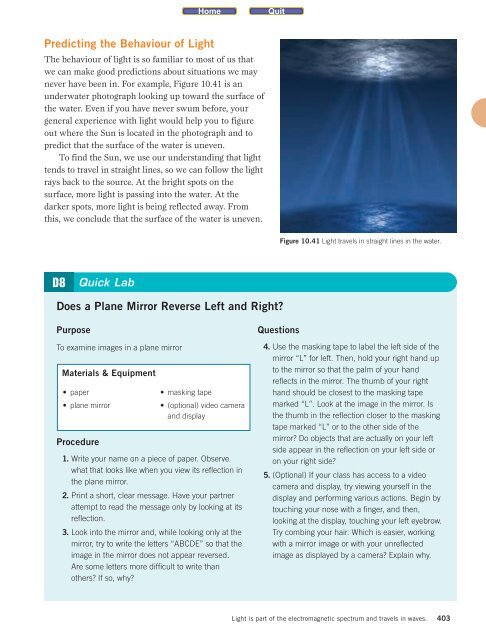is10_sb_unit_d
is10_sb_unit_d
is10_sb_unit_d
You also want an ePaper? Increase the reach of your titles
YUMPU automatically turns print PDFs into web optimized ePapers that Google loves.
Predicting the Behaviour of Light<br />
The behaviour of light is so familiar to most of us that<br />
we can make good predictions about situations we may<br />
never have been in. For example, Figure 10.41 is an<br />
underwater photograph looking up toward the surface of<br />
the water. Even if you have never swum before, your<br />
general experience with light would help you to figure<br />
out where the Sun is located in the photograph and to<br />
predict that the surface of the water is uneven.<br />
To find the Sun, we use our understanding that light<br />
tends to travel in straight lines, so we can follow the light<br />
rays back to the source. At the bright spots on the<br />
surface, more light is passing into the water. At the<br />
darker spots, more light is being reflected away. From<br />
this, we conclude that the surface of the water is uneven.<br />
D8 Quick Lab<br />
Does a Plane Mirror Reverse Left and Right?<br />
Purpose<br />
To examine images in a plane mirror<br />
Materials & Equipment<br />
• paper<br />
• plane mirror<br />
Procedure<br />
• masking tape<br />
• (optional) video camera<br />
and display<br />
1. Write your name on a piece of paper. Observe<br />
what that looks like when you view its reflection in<br />
the plane mirror.<br />
2. Print a short, clear message. Have your partner<br />
attempt to read the message only by looking at its<br />
reflection.<br />
3. Look into the mirror and, while looking only at the<br />
mirror, try to write the letters “ABCDE” so that the<br />
image in the mirror does not appear reversed.<br />
Are some letters more difficult to write than<br />
others? If so, why?<br />
Figure 10.41 Light travels in straight lines in the water.<br />
Questions<br />
4. Use the masking tape to label the left side of the<br />
mirror “L” for left. Then, hold your right hand up<br />
to the mirror so that the palm of your hand<br />
reflects in the mirror. The thumb of your right<br />
hand should be closest to the masking tape<br />
marked “L”. Look at the image in the mirror. Is<br />
the thumb in the reflection closer to the masking<br />
tape marked “L” or to the other side of the<br />
mirror? Do objects that are actually on your left<br />
side appear in the reflection on your left side or<br />
on your right side?<br />
5. (Optional) If your class has access to a video<br />
camera and display, try viewing yourself in the<br />
display and performing various actions. Begin by<br />
touching your nose with a finger, and then,<br />
looking at the display, touching your left eyebrow.<br />
Try combing your hair. Which is easier, working<br />
with a mirror image or with your unreflected<br />
image as displayed by a camera? Explain why.<br />
Light is part of the electromagnetic spectrum and travels in waves.<br />
403


